In this Article:
In this cartridge comparison, we are going to examine two cartridges that behave very similar in the ballistics category. The 7mm-08 vs .308 argument is a newer one, relative to some other cartridge arguments that have now been raging for nearly a century, in the hunting and shooting world, as the 7mm-08 was introduced in the 1980’s.
Both have their place in the hunting and competitive shooting world, and we will come out front stating that both can easily become your top cartridge choice when in the field under the right conditions.
In this article, we are not going to argue for one cartridge over the other but look objectively at the differences between these rounds in various performance categories. With this information, we are better able to draw conclusions as to which scenarios each of these cartridges will be better suited for use in specific shooting scenarios.
A Brief History
7mm-08 Remington
The 7mm-08 Remington was introduced in the 1980’s as a way to replicate the performance of the older 7×57 Mauser in a modern caliber and cartridge. The 7mm-08 was derived from necking down the neck of the .308 Win and allowed it to accept the smaller diameter 7mm bullet.
At the time of its arrival, the popularity of 7mm bullets was growing exponentially because of its ballistic performance and the lighter recoil compared to other larger hunting cartridges.
The 7mm-08 provides an excellent hunting cartridge for medium to large game. It was intended to provide lighter recoil while maintaining heavy enough bullet weight and velocity to effectively reach out and kill game efficiently. While the 7mm-08 has a loyal group of users, it’s popularity is not at the same level of other hunting cartridges. Even so, it has a variety of bullet weights, mostly within the 120-150grain weight although there are heavier rounds available that are closer to the common hunting rounds of the .308.
.308 Winchester
The .308 Winchester was introduced by Winchester in 1952 where it quickly became a staple in the American hunting world. Not long afterward, its performance specs were impressive enough to be adopted by the military and where it saw heavy use in Vietnam.
While the NATO version of this round was short-lived, it has and will continue to have a loyal and dedicated market for the avid hunter. This is a larger bullet with excellent range, penetration, and stopping power. It’s a great medium to large game cartridge and can be used for just about any large game animal in the world under the right conditions.
While the .308 has found its place in the hunting world, it’s performance has also proven reliable enough to find a spot in police and military sharpshooting units. And while it might not be as ubiquitous in these circles as it once was, the fact that it is still around in modern tactical units is a strapping commendation for the cartridge.
Because of the popularity of this cartridge, which comes from its performance, there is a wide variety of ammunition with various bullet weights and designs making it easy to match your ammunition with your intended hunting or shooting scenarios.
Specs
| 7mm-08 Rem | .308 Win | |
|---|---|---|
| Parent Casing | .308 Win | .300 Savage |
| Bullet Diameter | 0.284†| 0.308†|
| Neck Diameter | 0.315†| 0.3433†|
| Base Diameter | 0.470†| 0.4709†|
| Case Length | 2.035†| 2.015†|
| Overall Length | 2.8†| 2.8†|
| Case Capacity | 52.2gr | 56gr |
| Max Pressure (SAAMI) | 60,000 | 62,000psi |
We always like to take a brief look at the case and bullet specs of the two cartridges that we are going to be comparing. Not only does it give us some insights into how these two cartridges might behave, but we also have a sense of why they are similar or different when we look at the various ballistic and other performance characteristics. The 7mm-08 cartridge was derived from the .308 Win but necked down to accept a 7mm diameter bullet which we see with the smaller neck diameter of the 7mm-08 Rem. The casing of the 7mm-08 is slightly longer than the .308, and the elongated bullet sits down slightly into the casing which causes less powder to be able to be loaded when compared to the .308. The overall length of the cartridges are the same though the base diameter is slightly, and we mean slightly, wider for the .308 Win.
Even with those changes, case capacity and the max pressure that the casings can withstand between these two cartridges are very similar. What we will see is that when looking at ballistic performance between the 7mm-08 vs .308, there are a lot of similarities with some slight differences.
To compare these two cartridges, we have selected five types of rounds for each cartridge of various bullet designs and weights to give a broader perspective on how these cartridges differ. We realize that there are a lot of other options out there and there is a good chance that a round that you like might not be here. It doesn’t mean that we think it beneath these other rounds, we just had to have some cutoff and ten felt like a nice round number that gives us plenty of options without making the graphs too cluttered to gain any insights from.
And though we are only going to graph ten rounds, we compiled a lot more than that. To give you some piece of mind that our sample size is a better representation of the full complement of these cartridges, we will also present the averages of twenty rounds for each cartridge at the end of each section. The full list of rounds can be found at the end of the article.
These are also factory loads, and we decided to omit and hand loaded cartridges that are often loaded quite a bit hotter than factory loads. While handloading and the max specs of these cartridges is important and warrants discussion, it is beyond the scope of this article. The majority of people rely on factory loads, so we are going to limit this discussion to popular rounds that are available at retail stores.
Below we have listed the rounds we will be using for comparison.
 .308 Hornady BTHP Match 168gr
.308 Hornady BTHP Match 168gr .308 Winchester Super-X 180gr
.308 Winchester Super-X 180gr .308 Nosler Ballistic Tip 165gr
.308 Nosler Ballistic Tip 165gr .308 Federal Vital-Shok Ballistic Tip 150gr
.308 Federal Vital-Shok Ballistic Tip 150gr .308 Federal Gold Medal Sierra Matchking 175gr
.308 Federal Gold Medal Sierra Matchking 175gr
 7mm-08 Nosler Trophy Grade AccuBond 140gr
7mm-08 Nosler Trophy Grade AccuBond 140gr 7mm-08 Federal Vital Shok Nosler Partition 140gr
7mm-08 Federal Vital Shok Nosler Partition 140gr 7mm-08 Winchester Ballistic Silvertip 140gr
7mm-08 Winchester Ballistic Silvertip 140gr 7mm-08 Federal Power-Shok JSP 150gr
7mm-08 Federal Power-Shok JSP 150gr 7mm-08 Hornady Superformance SST 139gr
7mm-08 Hornady Superformance SST 139gr
Before we get the comparisons, we do want to briefly touch on where the numbers we will be using are coming from. The majority is taken directly from the manufacturer, and other data points have been generated by us through trusted ballistic calculators. These numbers might differ from numbers generated by other people through chronographs or other physical means through their gun platform. The reason computer-generated statistics are a good means for comparing two cartridges is because each gun might turn out slightly different numbers. So while these numbers might fluctuate depending on where you look and the rifle used, the trends we see should remain constant.
So, with all of that out of the way, let’s start digging into how the 7mm-08 vs .308 cartridges compare and contrast to each other.
Recoil
When deciding between cartridges, recoil is often a major factor that a lot of shooters take into account. It might be from fear of the kick, but most often it has to do with pulling off consecutive shots while maintaining accuracy. Recoil is something you have to deal with regardless of the cartridge, but the severity of the “kick†depends on what you are shooting.
In this section, we will take a look at the actual force that is produced when firing these two cartridges in ft.lb. What we are measuring doesn’t translate directly to “felt recoil” as other factors that are difficult to put a number to influences the amount of kick you feel. Regardless, more recoil energy from one round to the next often translates loosely to more kick.
When we look at the recoil energy generated from firing each of the ten rounds we have selected for comparison, we can see some trends emerge (Graph 1).
This data is generated from a ballistic calculator where we used the rounds muzzle velocity, bullet weight, gun weight (7lbs), and the powder charge. For the powder charge, we used Nosler load data and took the average of several common powder loads for each cartridge and kept that constant for each round of the same cartridge.
The .308 rounds tend to generate a few more ft.lb of force than it’s 7mm-08 counterpart. While there is some variability in the amount of recoil within each cartridge, both generate a substantial amount that can cause flinching when firing and throw off a shot. All of the .308 rounds are generating between 20 and 23.5ft.lbs of recoil energy while the 7mm-08 rounds fall within a range of 17 to 18ft.lbs. Whichever round you choose there is only a little over 6ft.lb of energy between the two cartridges. It might be enough to persuade some users to choice one over the other, but for most, the ballistics and other performance specs are going to carry more weight.
While this gives you a good idea about the amount of recoil that is generated from these two cartridges, it can fluctuate based on several factors such as gun weight, barrel length, and powder charge. For comparison purposes, we have kept as many variables consistent for each round, but the numbers fluctuate + or – a few ft.lb force depending on the powder charge used by the manufacturer (not available).
In the table below, you will find the average recoil data for both of these cartridges that we derived from a bigger sample of common factory loads. Let’s check out if we see the similar trends in recoil energy generated. We generated this data using the same variables as we described above.
Average Recoil (ft.lb)
| .308 Winchester | 7mm-08 Remington |
|---|---|
| 22.15 | 17.18 |
Like the previous data, we do see a few ft.lb difference between the two cartridges with the .308 Win producing right at five more ft.lb more than the 7mm-08, on average. As we discussed above, while the .308 consistently produces more recoil energy, we can’t say if it’s enough to sway you in the direction of either cartridge. You will have to consider other performance factors and then decide if a few ft.lb of energy is factor.
Ballistics
In this section, we will take a look at several ballistic categories for cartridge comparison. Understanding the ballistic properties of each cartridge will make it easier to tease apart under which hunting or other shooting applications these cartridges will excel at. We will look at velocity, ballistic coefficients, and trajectory at short and long range.
We also think that it is important to note that though we are looking at all of these categories individually and that is only giving you part of the picture. All of these categories including the categories outside of ballistics all go hand in hand and influence each other. We will attempt to bring all of this together when we get to the application section.
Velocity
The velocity of a bullet is an important factor when deciding on which cartridge you want to take out into the field. The higher the velocity, the less that certain environmental factors such as wind and gravity can affect the bullet’s trajectory. If bullets can stay above supersonic speeds (app 1,125ft/s), then these outside forces are minimal. When these factors can be minimized, the bullets remain on their desired path, and you get a more accurate shot.
For hunting purposes, you also need a certain velocity to get the correct terminal ballistics such as bullet expansion and penetration. Normally, the manufacturer will provide the amount of velocity needed.
So, let’s take a look at our ten rounds and see if we can see any differences in velocity between these two cartridges. We are examining the bullet’s velocity (ft/s) from the muzzle out to 500 yards, and all of the data was gathered from the manufacturer (Graph 2).
There is not a very noticeable difference in velocity between these two cartridges. On average, the 7mm-08 rounds have a higher velocity from the muzzle out to 500 yards, but there are several .308 rounds that perform as well as the 7mm-08. And the 7mm-08 on average is less than 100ft/s at each range marker. Rather than the rounds from each cartridge grouping tightly together with a distinct difference between the two cartridges, all of these rounds are intermixed. From this data, no cartridge has a distinct advantage in velocity, but rather, it depends on the individual round.
Regardless of which cartridge maintains higher velocities, one thing is for certain when looking at this graph, and that is both the .308 and 7mm-08 maintains excellent velocity throughout its flight path. Even at the 500-yard mark, all of these rounds maintain velocities above supersonic speeds; a very remarkable feat.
Let’s take a look at the average velocity for each of the cartridges when we bring in more factory loads. We will also present the average supersonic limits of both cartridges.
Average Velocity (ft/s)
| Yards | .308 Win | 7mm-08 |
|---|---|---|
| Muzzle | 2733 | 2841 |
| 100 | 2521.5 | 2617.9 |
| 200 | 2320 | 2410.9 |
| 300 | 2182 | 2198.7 |
| 400 | 1946.5 | 2021.2 |
| 500 | 1775 | 1833.2 |
When looking at the average velocities for these rounds, we see the same general trends as we did above. The 7mm-08 on average, has right around 100fps greater velocity than the .308 from the muzzle to 200 yards. From 300 to 500 yards, the 7mm-08 still has the edge, but the difference has lessened. And again, there are quite a few rounds from both cartridges that overlap in velocities and the differences between the averages wouldn’t be significant from a statistical standpoint.
For those who might not be familiar with why we want to know when a bullet falls below supersonic speeds, it is because the bullet becomes more destabilized when the sound wave it left behind catches up to it. From that point on, where the bullet ends up is a little dicier.
Average Supersonic Limit (Yards)
| .308 Winchester | 7mm-08 Remington |
|---|---|
| 1023.7 | 1035.5 |
When we look at the rate of velocity loss between these two cartridges, they are almost identical. Because of that, we would expect both to drop below supersonic speeds at around the same distance, which is what we see with these averages. On average, both are dropping to subsonic speeds right at 1,000 yards. These numbers were calculated with normal, sea-level environmental conditions which means these numbers can change depending on where and when you are shooting.
Ballistic Coefficient (BC)
The ballistic coefficient gives us an idea of how well a bullet is streamlined. When the variables are put into an equation, and we get the BC, a higher number tells us that the bullet has lower air drag, can resist crosswinds, and is less prone to wind drift than a bullet with a lower BC. This also translates to maintaining velocity, as well as accuracy.
So, let’s take a look at the ten rounds we have selected and see if there is any difference in ballistic coefficients between the two cartridges (Graph 3).
While there is not a definite and noticeable difference in the ballistic coefficients of these two cartridges, if we averaged all five rounds for each cartridge the 7mm-08 would be slightly higher (.44 vs .434). We don’t feel confident in saying that this is a trend you would see with any five rounds for each. It seems to depend heavily on the individual round rather than the type of cartridge, similar to what we observed with the velocity of these two cartridges. Below, we will look at a larger sample size which should give us a better idea of how these two cartridges compare in their ballistic coefficients.
Neither of these cartridges, at least the rounds we have selected, have ballistic coefficients that are similar to cartridges used for long range shooting competitions where there are shots coming at 500+ yards, but they are both high enough for normal shooting applications.
Average Ballistic Coefficient
| .308 Winchester | 7mm-08 Remington |
|---|---|
| 0.434 | 0.418 |
When we take into account a lot more rounds, we see that the results from our small sample size were not indicative of the two cartridges. With more samples, we actually see the .308 Winchester has a higher ballistic coefficient on average. Now, some hardcore guys might say that the 2/100s difference between the two makes a difference, but for most of us using factory loads, we would never know. It’s also important to realize that if we added twenty more rounds each, we might see the gap shrink even smaller or maybe flip. What we need to take away from this is that if you want a round with a higher BC, both of these cartridges have options in the high 0.4 to 0.5 range.
Trajectory
For competitive shooting at the range or for hunting purposes, the trajectory for a cartridge is of extreme importance, What you want to look for is a flat trajectory where the bullet will travel over a significant distance without losing too much elevation, which we will measure in bullet drop (inches). The more the bullet drops, the bigger the adjustments will need to be made to make an effective shot and the harder it is to be accurate on a consistent basis without a lot of od practice.
We will take a look at how both of these cartridges perform at short and long range with the rifle sighted in at a specific yardage. Before we do that, we wanted to give you a broader picture of how flat the trajectory is for these two cartridges. We have selected two very similar rounds from the same manufacturer that share a similar bullet weight, bullet design, and ballistic coefficient (Graph 4).
When looking at how flat the trajectory is between the 7mm-08 and .308, there is almost no noticeable difference between the two. As we have mentioned before, and are bound to mention again before the article is over, these two cartridges are very similar. From this graph, we never see more than 2 inches difference in bullet drop throughout the 500-yard range.
Let’s zoom in on sections of this total range with several different rounds for each cartridge and see if any differences are more noticeable.
Short Range Trajectory
Both of these cartridges are great short range hunting rounds for medium to larger size game. If we compare these rounds from the two cartridges in the short range, zeroed in at 100 yards. The data was collected from the manufacturer, when available, and generated with a ballistics calculator using the bullets weight, the muzzle velocity, and the ballistic coefficient (Graph 5).
At the 200 yard mark, all of the rounds are within three inches of each other, and the averages between the two (3.68 for the 7mm-08 and 4.03 for the .308) are less than half an inch. We also do not see any trends in the two cartridges grouping individually. If we take it out to the 300-yard mark, there are more distinct differences in bullet drop, and we do see more of the .308 rounds showing slightly more bullet drop than the 7mm-08 rounds. If we look a bit closer, we still see that all of the rounds fall within four and a half inches of each other. The 7mm-08 on average does show a little more than an inch less bullet drop.
Even looking at the two rounds with the largest difference, it’s still only six inches. Now, six inches can be a pretty big difference when the buck of a lifetime is in the crosshairs, but overall, these cartridges perform analogously in short range trajectory.
Let’s take a look at the average trajectory for these two cartridges at short range when we include more rounds.
Average Bullet Drop (Inches) at Short Range
| Yards | .308 Win | 7mm-08 |
|---|---|---|
| 50 | -0.125 | -0.165 |
| 100 | 0 | 0 |
| 200 | -4 | -3.57 |
| 300 | -14.5 | -13.2 |
| 400 | -32.8 | -30 |
From these numbers, we do see a slight advantage for the 7mm-08 Remington. It shows slightly less bullet drop than the .308 Winchester from a half inch at 200 yards to 2.8 inches at 400 yards. And as we say a couple times through this article, you’re not shooting averages out in the field, but if a flatter trajectory is the main factor you are basing your decision on, the averages show that there will be more options with slightly flatter trajectories for the 7mm-08 Rem. But, as we saw when looking at the smaller sample sizes that we graphed, there are flat shooting options for both cartridges.
Long Range Trajectory
Let’s zoom back out a few hundred yards and look at the long-range trajectory of the 7mm-08 vs .308. For some medium to large game hunting, there are often shots that are going to be taken at 300+ yards, so understanding how these cartridges perform at this range is important for your cartridge consideration. These ranges are also going to more interesting to competition shooters or just hobbyists who like to test their skills on the range.
Like the short range trajectory, we are looking at the bullet drop in inches of these ten rounds. The firearms were zeroed in at 200 yards and measurements are taken from 100 to 700 yards at 100-yard intervals. Data was collected with the same methods as the short range trajectory (Graph 6).
Again, we do not see any clear trends between the two cartridges even out to the 500-yard mark. From 300 to 500 yards the cartridges group pretty tightly, though the 7mm-08 rounds tend to be a little flatter. The average bullet drop between these two cartridges never exceeds three inches.
A the 600 and 700 yard mark we do see the rounds from the two cartridges begin to space out with the 7mm-08 rounds showing an average bullet drop of 80.6in (600 yards) and 120in (700 yards) compared to an average bullet drop of the .308 rounds of 91.5in (600yards) and 133.7in (700 yards). With that being said, there are .308 rounds that outperform some 7mm-08 rounds in flat trajectory. Again, a lot depends on the round you are using rather than the cartridge.
In the table below, you can find the averages for the bullet drop of both cartridges at long range.
Average Bullet Drop (Inches) at Long Range
| Yards | .308 Win | 7mm-08 |
|---|---|---|
| 100 | 2 | 1.79 |
| 200 | 0 | 0 |
| 300 | -8.5 | -7.6 |
| 400 | -24.7 | -22.8 |
| 500 | -50.3 | -46.7 |
| 700 | -137.6 | -125.9 |
| 1000 | -401.6 | -373.3 |
When we bring in more rounds, the average follows the same trend we saw with the previous set of rounds. All the way out to 500 yards, there is less than four inches of difference or less. And if the averages are that close, you know there will be a lot of overlap as we saw in the graph.
Even out at 700 yards, there is only 12 inches of difference. While that can certainly make a difference, factory loads of these two cartridges are not often used for such extreme ranges, though there are factory loads developed specifically for that application. From ranges within 500 yards, there is less than 4 inches of difference between the averages at 500 yards and even less as you move down to the zero mark.
Stopping Power
When selecting a hunting cartridge, stopping or knockdown power probably gets more attention than any other ballistic or performance category. Obviously, the bullet that you are sending downrange needs enough force to bring down an animal quickly and humanely and doesn’t involve you tracking an animal 1,000 yards after the shot.
There’s a lot that is involved in a bullet’s effectiveness for bringing down game such as energy, penetration, fragmentation, and wound type. This alone could be an article on its own, so for simply comparing two cartridges, we are going to stick with bullet energy, potential for penetration, and bullet momentum. The main reason for sticking with these three is because the numbers that are generated are better for comparing two cartridges rather than individual rounds where something like ballistic gels would be very useful.
And we will go ahead and state now that we do not believe any one of the three components we will look at are the perfect indicator for how well any of these rounds are going to bring down game. Even when considering all three, there are still pieces to the puzzle that we are leaving out. And perhaps the biggest piece of the puzzle is how good a shot you are. Still, looking at the three components to stopping power here still gives us a lot of information as to how these two popular hunting cartridges compare.
Energy
When the bullets are forced downrange by the lit powder, they carry kinetic energy that is generated by the energy from the ignited powder and the mass of the bullet. When the bullet reaches the target, this energy is transferred to the target where massive tissue and organ damage occurs.
As a general rule, you want at a minimum of 1,000 ft.lb force when trying to take down larger game such as deer, and probably more than that when talking about bear, elk, and moose which these cartridges are often used for. We do think that the amount of energy a bullet is carrying is important to know and understand when using these rounds for hunting purposes, but we also know that those guidelines are arbitrary. Shot placement is equally if not more important than the amount of energy that the bullet is carrying.
We are going to be measuring the force or energy that is carried by these different rounds from our two cartridges (ft.lb) from the muzzle out to 500 yards. This data was compiled from the manufacturer (Graph 7).
The heavier .308 rounds do start out with more energy out of the muzzle than all of the 7mm-08 rounds we have selected and tend to maintain the lead throughout the 500-yard range, but the 7mm-08 rounds are not that far off regarding force either. At the 300 yard mark and beyond, the average bullet energies for these two cartridges are within 100ft.lbs of each other. We do see that it is the .308 rounds that carry the most energy, but there are 7mm-08 rounds such as the Hornady SST that carries more energy than several .308 rounds.
All of these rounds have well over 1,500ft.lb of force at the 200-yard mark, and some of them still carry this amount of force out to 300 yards. Even at the 500-yard mark, all of these rounds, other than the 7mm-08 Federal Power Shok 150gr round have right at or more than 1,000ft.lb of force. The issue is getting the bullets on target at that range.
Overall, there doesn’t appear to be much difference between the two cartridges, at least not with the rounds we have selected. You can find both .308 and 7mm-08 rounds that might offer more energy than what we have used in this comparison, but one cartridge is not a clear-cut winner in this category. Though some might carry more energy, it is never so much more that it will be better suited for dropping game, especially if both are well places in the vitals.
While there doesn’t appear to be much of a gap between these two cartridges when looking at these selected rounds, let’s take a look at the averages when we add in some more rounds for each cartridge.
Average Bullet Kinetic Energy (ft.lbs)
| Yards | .308 Win | 7mm-08 |
|---|---|---|
| 0 | 2723 | 2464.9 |
| 100 | 2319.9 | 2094.6 |
| 200 | 1966.5 | 1777.5 |
| 300 | 1657.9 | 1490.1 |
| 400 | 1389.7 | 1252.1 |
| 500 | 1109.5 | 1034.8 |
When we look at a much larger sample size, we see the same trends as previously, with the .308 Win rounds carrying more kinetic energy from the muzzle out to 500 yards than the 7mm-08 rounds. We do see the average KE for the .308 Win rounds increase slightly compared to our smaller sample size. And again, these are just averages, but if you are wanting a round with the more kinetic energy, there are going to be more options in the upper end of the energy range with the .308 Win. Of course, as we saw in the previous graphs, there is a lot of overlap between these rounds.
Penetration
The ability of the bullet of specific cartridge to penetrate into the target is another critical factor in stopping power. Deep penetration is not always wanted for every situation, but for larger game with thick tissue and bones, you need deep penetration to reach and damage vital organs.
One method used to compare a cartridges penetration is to use the sectional density of the bullets. This number comes from a calculation using a bullet’s weight and diameter. Higher sectional densities let us know that the bullet will be able to penetrate deeper. In this comparison, we exclude how a bullet will expand or fragment for simplicity sake.
We have taken the ten rounds we have selected for this comparison and graphed them below (Graph 8).
The sectional densities of these two rounds bring up some interesting talking points. The first is obvious that both of these cartridges feature near equivalent sectional densities. The average SD for the 7mm-08 rounds is 0.251 while the average for the .308 is 0.26. This is interesting because the 7mm-08 is using lighter weight bullets. For instance, the 140gr 7mm-08 rounds have the same sectional density as the 165gr .308 round.
This occurs because of the smaller diameter of the 7mm-08 which allows more pressure to be localized to a smaller area which provides deeper penetration. This is a big draw to the 7mm-08, better trajectories and the same amount of stopping power and penetration are big selling points. And as we saw with the energy comparison. There is not a big enough difference to pick one over the other based on penetration alone. They both have the potential for deep penetration, and the sticking point for choosing a round is going to be based on the bullet design.
Now, these results might not hold up when we look at a lot more rounds added into the equation and is what we see when we look at our larger sample size in the table below.
Average Sectional Density
| .308 Winchester | 7mm-08 Remington |
|---|---|
| 0.248 | 0.258 |
In this case, we still see the two cartridges have pretty similar averages, which tells us that we will see a lot of overlap between the two with rounds for both cartridges having options with higher sectional densities. We do see the average for the 7mm-08 Remington bump up to .258 while the average for the .308 Win rounds drops down to 0.248 mainly because of the addition of lighter 150gr bullets. Again, it’s not big enough difference seen across the board to make a lot of assumptions about which cartridge has deeper penetration.
Momentum
When we talk about momentum in the context of bullets, we are looking basically looking at how well the bullets can overcome resistance. Momentum is simply how well an object in motion can stay in motion. This is important for both hunters and tactical shooters. More momentum is not always what you need, it’s really going to depend on what the scenario is. Tactical marksmen might want more momentum as that is an indicator for passing through obstructions or armor. The same principles go for hunters who might want more momentum if they are hunting game with thick hide and bones but still need a round that is going to pass through. Other situations might not require that high of bullet momentum to be effective. And you still have to take into account the design of the bullet.
Let’s take a look at the bullet momentum of our ten rounds in the graph below (Graph 9).
We see in this graph that the rounds do tend to group together based on cartridge type, but there is some overlap between the two at more distant markers. The .308 Win rounds do tend to generate a decent amount more momentum at the muzzle than the 7mm-08 rounds and this continues through the 500 yard mark, but at that distance, the difference between the two cartridges has closed by several lbs/ft.s.
Let’s take a look at the momentum data when we add fifteen extra rounds for each cartridge.
Average Bullet Momentum (lb/ft.s)
| Yards | .308 Win | 7mm-08 |
|---|---|---|
| Muzzle | 64.1 | 55.8 |
| 100 | 59.1 | 51.45 |
| 200 | 54.4 | 47.4 |
| 300 | 49.9 | 43.4 |
| 400 | 45.7 | 39.48 |
| 500 | 41.7 | 36.36 |
We seem from these averages that the .308 Winchester rounds carry an average of 9 down to five more lbs/ft.s more momentum than the 7mm-08 Remington rounds. And if you look at the equation for momentum, it makes sense that these rounds generate a fair amount more momentum than the lighter 7mm-08 Remington rounds. And there are still 7mm-08 rounds that have more similar momentum numbers than others, the .308 Win cartridge is, more often than not, going to provide more bullet momentum which is something we will discuss in the applications section.
Accuracy
Accuracy is a tough comparison when looking at different cartridges. We believe that a lot more goes into accuracy than just the type of cartridge. Most noticeably is the person doing the shooting. Your firearm, as well as the specific type of round, also play a large role. About the only way to measure accuracy is to take all of these rounds on the range and measure groupings, but even that method has a lot of variables that can’t be controlled and could easily differ from day to day.
Still, we can make some assumptions about accuracy based on some of the data we have already looked at, and we can discuss that here.
Both cartridges have near identical velocities. On average, the 7mm-08 might have slightly higher velocities and ballistic coefficients which would help keep them on the correct trajectory when used in the field. Take this with a grain of salt, as there are .308 rounds out there that have the same or better performance specs in this category.
For the trajectories of the two cartridges, we saw that their performance was very similar and depended on the specific type of round that you are using. For this comparison, though it was a small sample size, the 7mm-08 rounds show a slightly flatter trajectory than the .308, especially at long yardage shots. Up to 150-200 yards, both of these rounds perform nearly identically.
Recoil can also play a role in accuracy. A heavy recoil in the hands of a less experienced shooter can cause flinching which is a major reason for missed shots in the field. From our comparison, the .308 generated slightly more recoil than the 7mm-08. With that being said, both of these cartridges produce enough recoil to affect the accuracy of a shot, and especially quick follow up shots.
So, given all this, we don’t think that anyone can come out and say with certainty which of these are more accurate. The 7mm-08 vs .308 arguments over accuracy gets heated for a lot of people, but the truth is they probably have just practiced with one more than the other. A good marksman can be highly accurate with both of these cartridges.
Price and Availability
While we don’t think that the price of ammunition should be the sole deciding factor when choosing between two cartridges, it does play a role for a lot of us. We have listed the price for 20 rounds of our selected ammunition used in this article for comparison. Like most of the ballistic properties we have looked at between these two cartridges, there is not much of a difference between the price either. Of course, these prices are subject to change based on the market.
The .308 rounds might be slightly cheaper than the 7mm-08, but both have specific brands of ammunition that will be extremely cheap and very expensive.
| Ammunition | Price (20 Rounds) |
|---|---|
| .308 Hornady BTHP Match 168gr | $22.89 |
| .308 Winchester Super-X 180gr | $21.99 |
| .308 Nosler Ballistic Tip 165gr | $30.99 |
| .308 Federal Vital-Shok Ballistic Tip 150gr | $31.99 |
| .308 Federal Gold Medal Sierra Matchking 175gr | $25.99 |
| 7mm-08 Nosler Trophy Grade AccuBond 140gr | $44.99 |
| 7mm-08 Federal Vital Shok Nosler Partition 140gr | $35.99 |
| 7mm-08 Winchester Ballistic Silvertip 140gr | $31.99 |
| 7mm-08 Federal Power-Shok JSP 150gr | $25.49 |
| 7mm-08 Hornady Superformance SST 139gr | $25.99 |
While both of these cartridges are in use, especially in the hunting niche, and the 7mm-08 is a derivative of the .308 cartridge, the 7mm-08 cartridge is much more difficult to come by. Larger retail stores that carry ammunition will most often have it in stock, but there are fewer options for bullet styles and weights available when compared to the .308.
Applications
As we move through these sections, we have also added all of the average tables we have used throughout the article below for quick viewing.
For the 7mm-08 vs .308, there is not a whole lot of differences in their applications. Both cartridges are extremely similar, and you have to canvas a lot of different rounds and split hairs to find significant differences in ballistic performance.
Both are great rounds for medium to large game at short ranges. When you get out past 300 yards, the stopping power is still there, but the changes in trajectory make putting a shot on target more difficult but is still manageable depending on the user. You might get a flatter trajectory out of the 7mm-08, but there are .308 rounds out there that can also provide a flatter trajectory as well.
Both of these cartridges have more than enough stopping power at close range for just about any game animal in North America and medium sized game at increased distances. As we discussed in the stopping power section, these light loads, when the correct type of bullet design is used, can provide just as much penetration of the heavier .308 rounds making them efficient for medium to large game as well. It’s an extremely versatile cartridge.
We also saw that both of these cartridges have pretty similar momentum numbers though the .308 Win, on average, carries several more lbs/ft.s of momentum than the 7mm-08 Remington rounds. Is this enough difference to sway your choice to one cartridge or the other? We’re not too sure. For hunting purposes, the extra momentum might give you a little piece of mind if you’re hunting bigger where you really need something to pass cleanly through the animal. And we know for a fact that there will be some of you out there who have taken big game with 7mm-08 rounds. So just from the numbers, the .308 Win might seem like a better choice in these situations but it’s by no means a runaway favorite. You also have to take into account the sectional density. There was a slight advantage for the 7mm-08 rounds which might bring them up in potential penetration and make up a little for the lack of momentum.
Tactically, this difference in momentum might be a plus for the .308 Win. But in this case, it’s not just because of the numbers, but there are very few options for tactical 7mm-08 rounds. The .308 Win has been used and still is used by military and police force personnel and the momentum of the cartridge is an added benefit to punch through tough armor and obstacles.
The recoil of the .308 cartridge is slightly more pronounced than the 7mm-08 and if flinching might be an issue for you than the 7mm-08 might be a better option. Still, both might be a bit much for a new hunter or shooter to cut their teeth on. If you are into long range shooting or most of your shooting comes from on the range, you might lean towards the 7mm-08 just because of the decreased recoil and the slight advantage in trajectory. As far as the BC comparison goes, there were some better options with the .308, but you have to weight it with trajectory.
While this might deviate a bit from actual cartridge comparison, firearms chambered for the 7mm-08 are a bit lighter than .308 chambered firearms. Both are short action, which makes them great for hauling around in thick wooded areas.
We think that the deciding factor in picking between these rounds is going to be the availability. There are many more firearms available chambered for the .308 than the 7mm-08, and you’re going to have an easier time finding the exact type of .308 rounds that fit your needs than you will the 7mm-08.
Best Rounds
At the end of these cartridge comparisons, we like to take a look at the ten rounds we have been using throughout the article and pick a couple of rounds from each cartridge that we think would suit specific shooting applications. We don’t think our picks are the uncontested best, in fact, we think there are a lot of rounds that can excel in these situations. In the end, whatever you are confident in using is going to be a good pick.
Top Hunting Round
For the .308 Win, we like the Nosler Ballistic Tip 165gr. This is another excellent option for medium to larger game. The bullet energy is the highest of the selected .308 rounds with 1,300ft.lbs of energy at the 500-yard mark which is enough for even larger game at that range. With proper shot placement, this round still has the energy and the velocity for proper terminal ballistics and making a clean kill. Anything within that yard mark is no issue at all. For the .308 rounds, it has one of the best long-range trajectories where a 300-yard shot is no problem in the right hands, and 400 yards is manageable though you are getting into territory where environmental factors might influence the round with the ballistic coefficient it has.
For the 7mm-08 we are impressed with the 140gr Nosler Trophy Grade AccuBond round. This is a great round for medium to large game with the AccuBond bullet providing deep penetration. It has well over 1,000ft.lb of energy at 500 yards, so you don’t have to worry about having the energy to drop game at any reasonable distance. It has an excellent BC for a hunting round at .421 and only 12 inches of bullet drop at 300 yards when zeroed in at 100 yards.
Top Range Round
For our top .308 Win range round we like the 168gr Hornady BTHP Match. This round is affordable which is an important consideration when you plan burning through quite a few out on the range. This round has a great BC for .308 rounds (.45), and when paired with the velocity and long-range trajectory, you have an excellent round for precision shooting.
For competition shooting, you are most likely going to turn to hand loaded rounds, but for the five factory loads we have looked at, we would go with the 139gr Hornady Superformance SST round. It’s an affordable 7mm-08 round that has tremendous velocity and a high BC of .486. This round also has an extremely flat trajectory for a factory load with only 39 inches of bullet drop at 500 yards and 105 inches at 700 yards. With 18ft.lb or recoil energy, you can shoot all day with some gun support at the range without getting fatigued.
Special Offer: Join our private community and get exclusive gun deals, handpicked gear recommendations and updates on law changes, every day!
Join our private community
Conclusion
Having drastic differences in cartridge performance is not always the case as we have shown here. When discussing the 7mm-08 vs .308, we have to split hairs to find significant differences in the cartridges’ ballistic performances.
Still, there is enough difference between these two cartridges to operate in both the same and different niches. We hope that this article has given a more clear train of thought as to these small differences and better addressed how these differences translate to performance in the field.

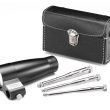
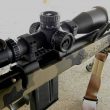
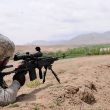
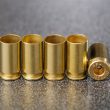
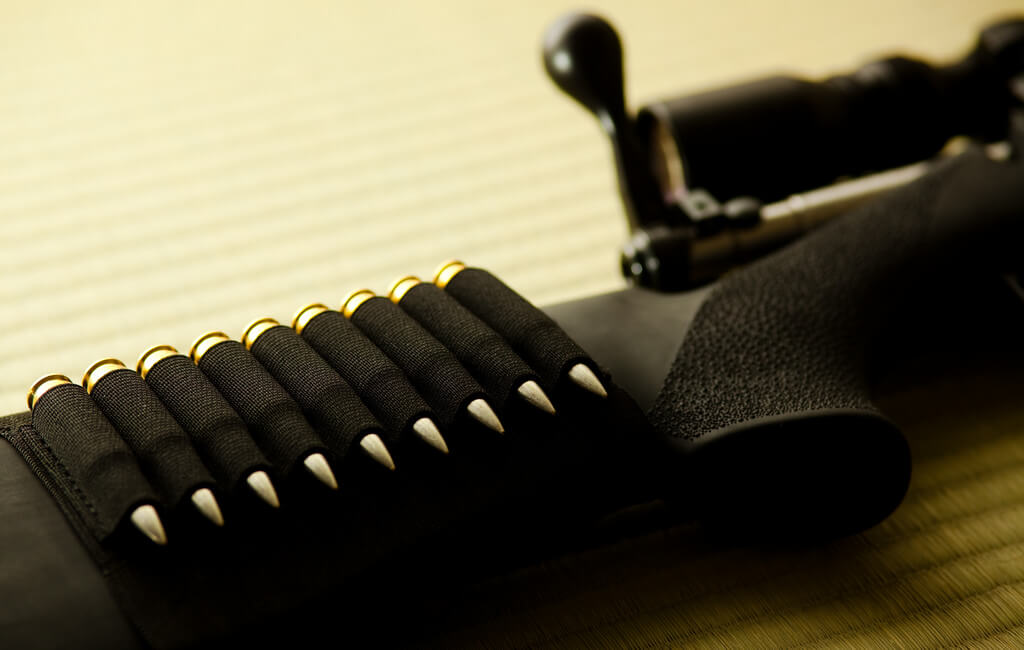
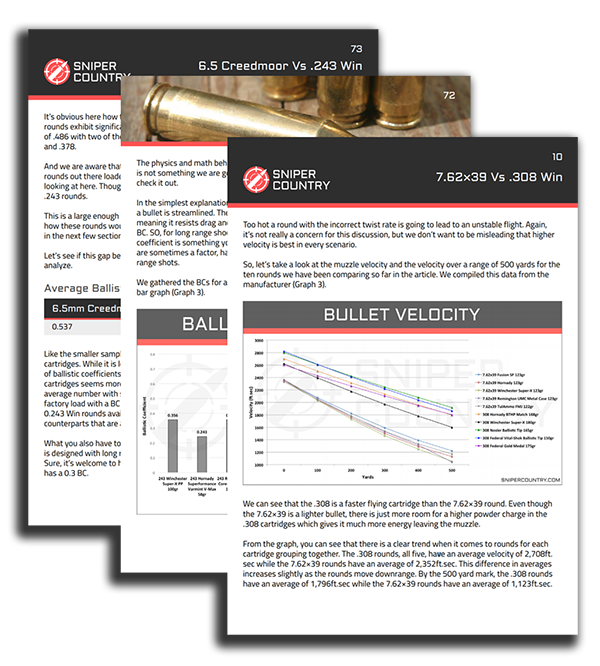

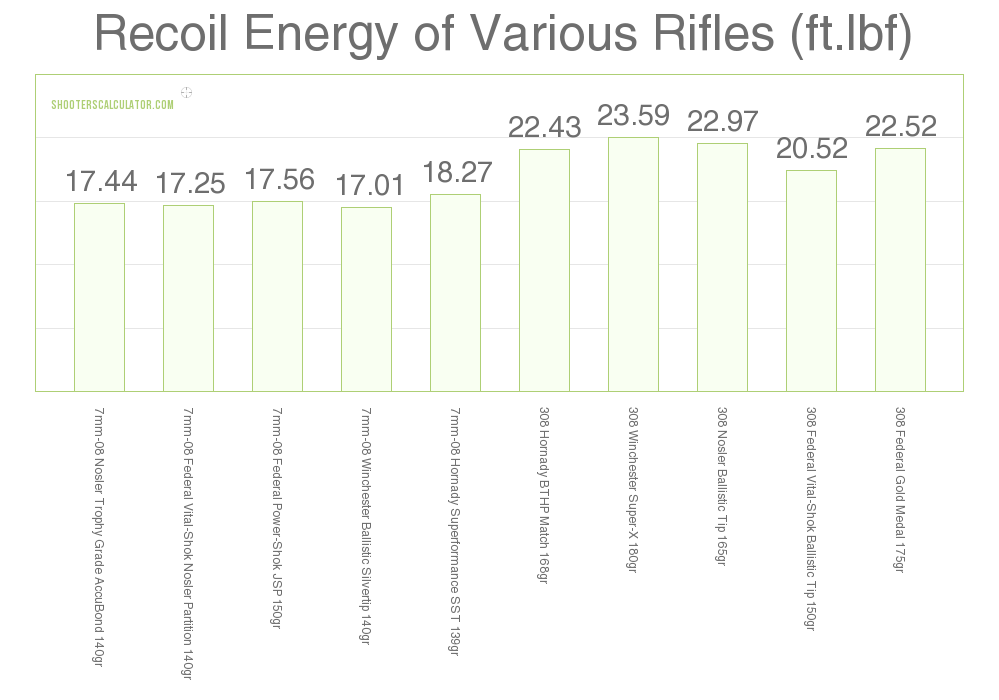
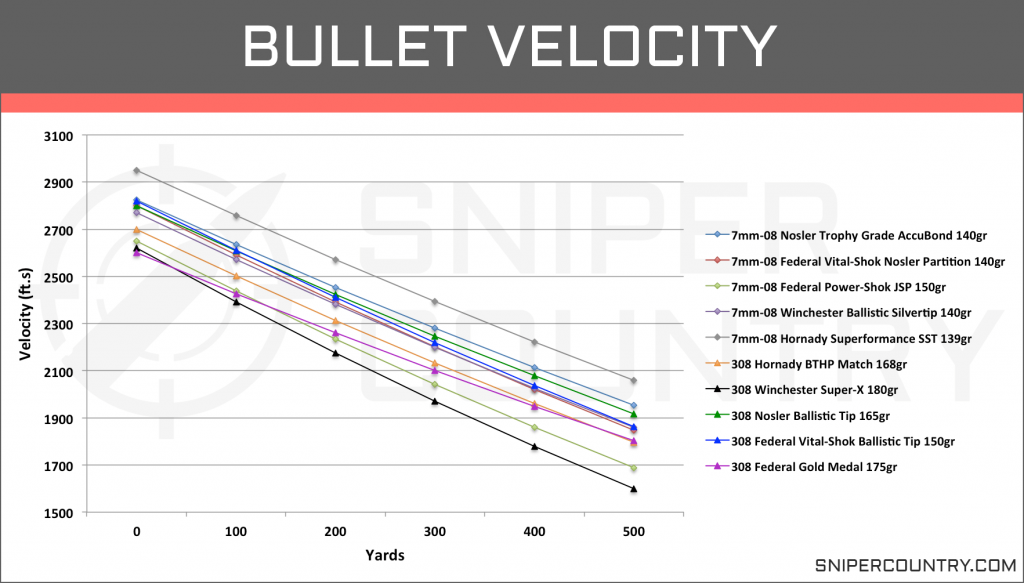
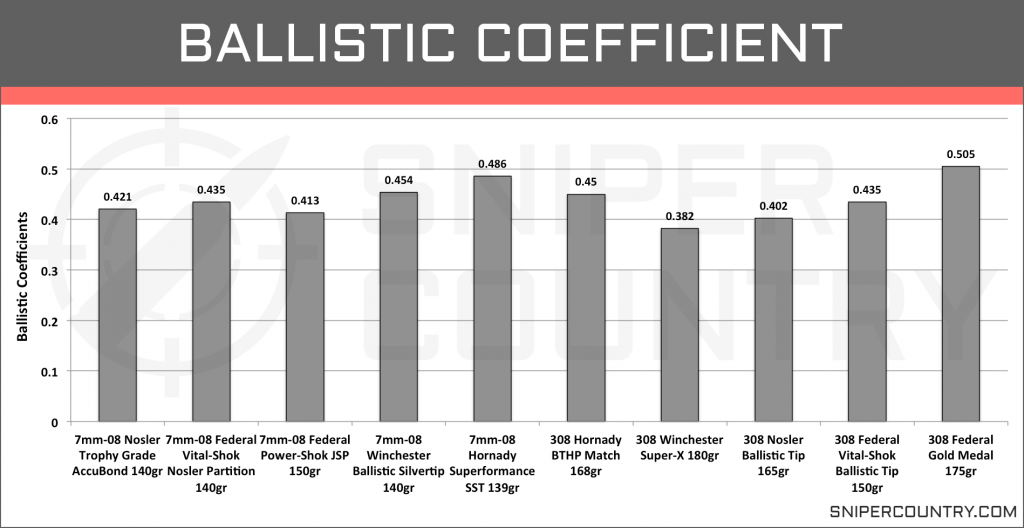
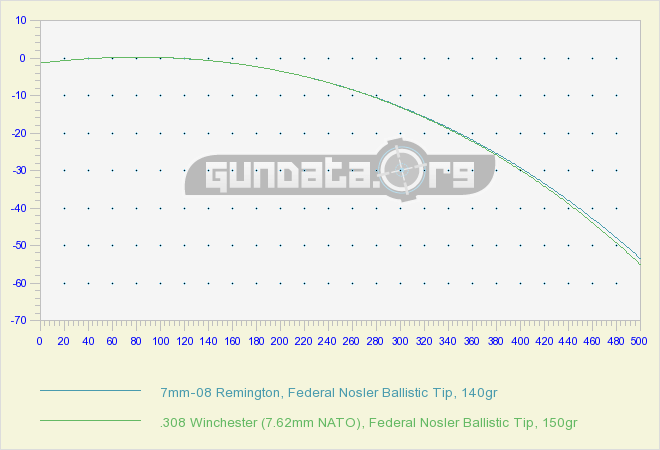
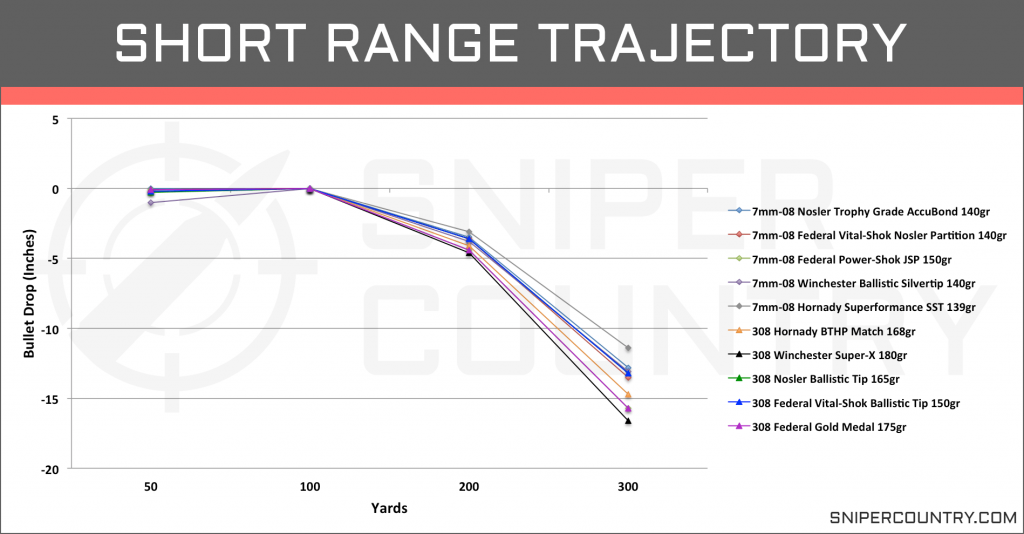
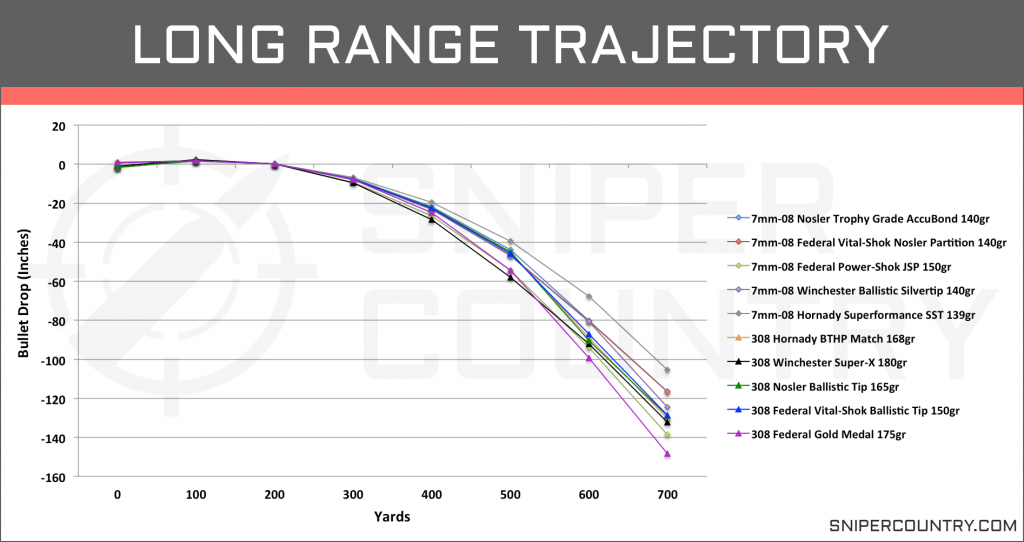
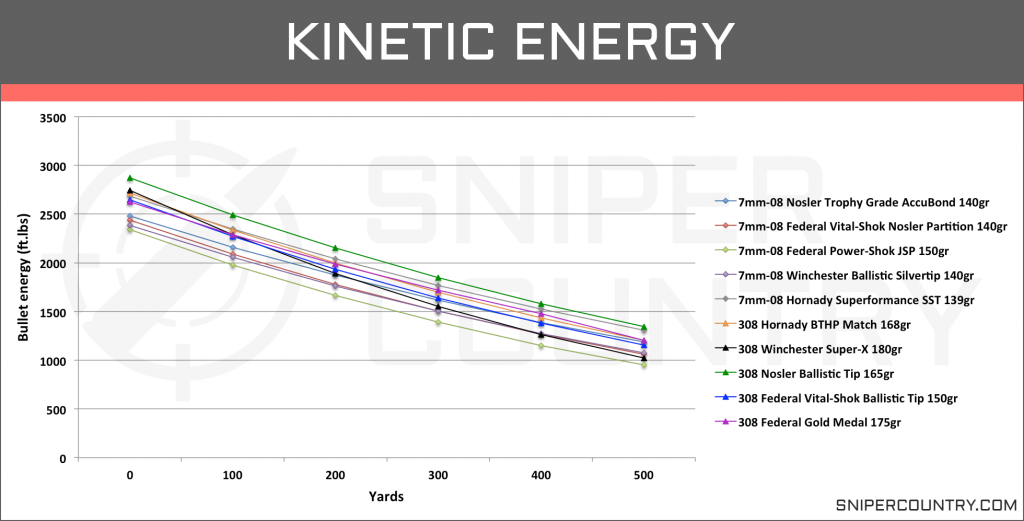

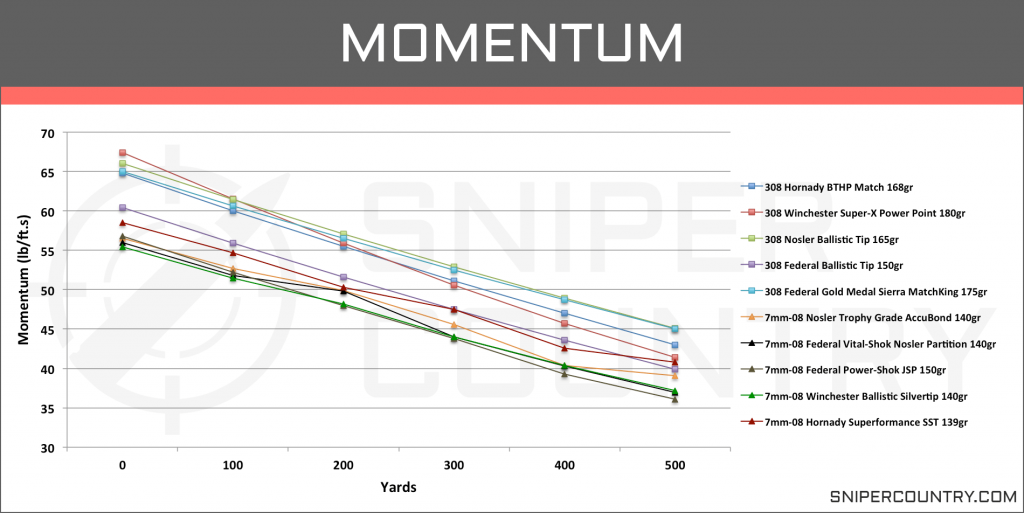
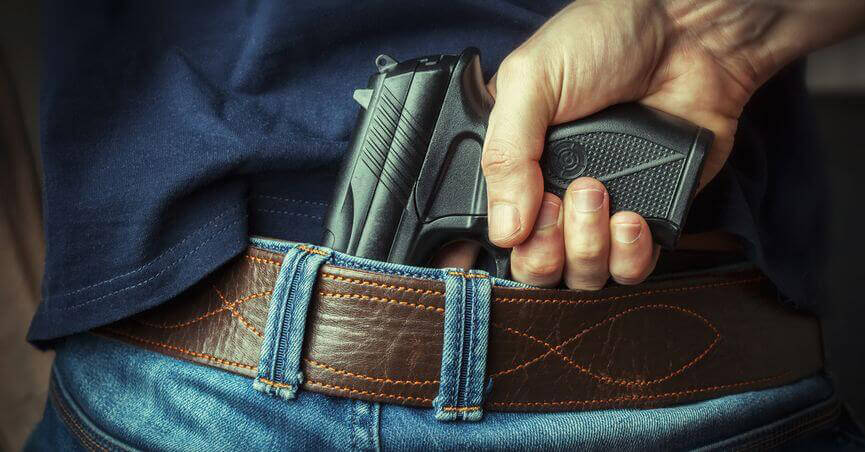
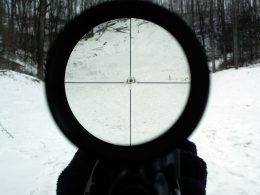
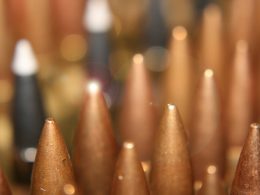
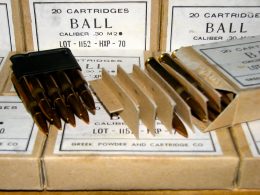
Thank you so much Huston for this review.
I shoot both catridges.The 308 seems to me too kill a little bit faster.But certainly only because of the bullet. for example,a Hornady 308 soft point is a instant killer,the Serra gameking not (anyway, no game was going more than 30 yards ).
Ps: Great report and salutations from Switzerland
Great article, I love that you present the facts and let the reader interpret them. A review like this is priceless. Thanks.
Great review. Details and approach was just what someone needs to compare these two cartridges.
Great unbiased analysis nothing is left out.
Great comparison you have made my choice concrete
Average numbers?
WHY?
Look at modern 7mm bullets with high BC, and compare usable case capacity with seated bullets.
Take the 7mm 168gr ABLR as example, with a good powder you get 2730 fps muzzle velocity, that translates to 2780 ft.-lbs.
SD is 0.316
The 7mm-08 was created for target shooters who wanted a bit less recoil than the .308 win. Inside of 400 yards(where 99% of game are shot) the stats seem to favor the .308 win… with near equal velocity yet more energy and a larger bullet diameter. Both are two of the finest cartridges available for both target shooting as well as hunting medium to large non dangerous game.